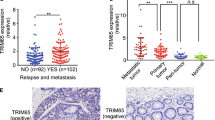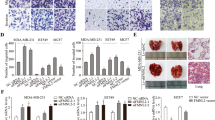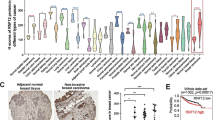Abstract
Protein geranylgeranylation (GGylation) is an important biochemical process for many cellular signaling molecules. Previous studies have shown that GGylation is essential for cell survival in many types of cancer. However, the molecular mechanism mediating the cell survival effect remains elusive. In this report, we show that the Hippo pathway mediates GGylation-dependent cell proliferation and migration in breast cancer cells. Blockade of GGylation enhanced phosphorylation of Mst1/2 and Lats1, and inhibited YAP and TAZ activity and the Hippo-YAP/TAZ pathway-dependent transcription. The effect of GGylation blockade on inhibition of breast cancer cell proliferation and migration is dependent on the Hippo-YAP/TAZ signaling, in which YAP appears to regulate cell proliferation and TAZ to regulate cell migration. Furthermore, GGylation-dependent cell proliferation is correlated with the activity of YAP/TAZ in breast cancer cells. Finally, Gγ and RhoA are the GGylated proteins that may transduce GGylation signals to the Hippo-YAP/TAZ pathway. Taken together, our studies have demonstrated that the Hippo-YAP/TAZ pathway is essential for GGylation-dependent cancer cell proliferation and migration.
This is a preview of subscription content, access via your institution
Access options
Subscribe to this journal
Receive 50 print issues and online access
$259.00 per year
only $5.18 per issue
Buy this article
- Purchase on Springer Link
- Instant access to full article PDF
Prices may be subject to local taxes which are calculated during checkout









Similar content being viewed by others
References
Reid TS, Terry KL, Casey PJ, Beese LS . Crystallographic analysis of CaaX prenyltransferases complexed with substrates defines rules of protein substrate selectivity. J Mol Biol 2004; 343: 417–433.
Yokoyama K, Goodwin GW, Ghomashchi F, Glomset JA, Gelb MH . A protein geranylgeranyltransferase from bovine brain: implications for protein prenylation specificity. Proc Natl Acad Sci USA 1991; 88: 5302–5306.
Clark EA, Golub TR, Lander ES, Hynes RO . Genomic analysis of metastasis reveals an essential role for RhoC. Nature 2000; 406: 532–535.
Lim KH, Baines AT, Fiordalisi JJ, Shipitsin M, Feig LA, Cox AD et al. Activation of RalA is critical for Ras-induced tumorigenesis of human cells. Cancer Cell 2005; 7: 533–545.
Olson MF, Paterson HF, Marshall CJ . Signals from Ras and Rho GTPases interact to regulate expression of p21Waf1/Cip1. Nature 1998; 394: 295–299.
Jackson JH, Cochrane CG, Bourne JR, Solski PA, Buss JE, Der CJ . Farnesol modification of Kirsten-ras exon 4B protein is essential for transformation. Proc Natl Acad Sci USA 1990; 87: 3042–3046.
Berndt N, Hamilton AD, Sebti SM . Targeting protein prenylation for cancer therapy. Nat Rev Cancer 2011; 11: 775–791.
Buhaescu I, Izzedine H . Mevalonate pathway: a review of clinical and therapeutical implications. Clin Biochem 2007; 40: 575–584.
Cuello FM, Kato CS, Diaz SD, Owen G . Effects of statins in cancer. Rev Med Chil 2013; 141: 227–236.
Onono F, Subramanian T, Sunkara M, Subramanian KL, Spielmann HP, Morris AJ . Efficient use of exogenous isoprenols for protein isoprenylation by MDA-MB-231 cells is regulated independently of the mevalonate pathway. J Biol Chem 2013; 288: 27444–27455.
Laufs U, Marra D, Node K, Liao JK . 3-Hydroxy-3-methylglutaryl-CoA reductase inhibitors attenuate vascular smooth muscle proliferation by preventing rho GTPase-induced down-regulation of p27(Kip1). J Biol Chem 1999; 274: 21926–21931.
Denoyelle C, Vasse M, Korner M, Mishal Z, Ganne F, Vannier JP et al. Cerivastatin, an inhibitor of HMG-CoA reductase, inhibits the signaling pathways involved in the invasiveness and metastatic properties of highly invasive breast cancer cell lines: an in vitro study. Carcinogenesis 2001; 22: 1139–1148.
Goard CA, Chan-Seng-Yue M, Mullen PJ, Quiroga AD, Wasylishen AR, Clendening JW et al. Identifying molecular features that distinguish fluvastatin-sensitive breast tumor cells. Breast Cancer Res Treat 2014; 143: 301–312.
Sun J, Qian Y, Chen Z, Marfurt J, Hamilton AD, Sebti SM . The geranylgeranyltransferase I inhibitor GGTI-298 induces hypophosphorylation of retinoblastoma and partner switching of cyclin-dependent kinase inhibitors. A potential mechanism for GGTI-298 antitumor activity. J Biol Chem 1999; 274: 6930–6934.
Dan HC, Jiang K, Coppola D, Hamilton A, Nicosia SV, Sebti SM et al. Phosphatidylinositol-3-OH kinase/AKT and survivin pathways as critical targets for geranylgeranyltransferase I inhibitor-induced apoptosis. Oncogene 2004; 23: 706–715.
Falsetti SC, Wang DA, Peng H, Carrico D, Cox AD, Der CJ et al. Geranylgeranyltransferase I inhibitors target RalB to inhibit anchorage-dependent growth and induce apoptosis and RalA to inhibit anchorage-independent growth. Mol Cell Biol 2007; 27: 8003–8014.
Vogt A, Sun J, Qian Y, Hamilton AD, Sebti SM . The geranylgeranyltransferase-I inhibitor GGTI-298 arrests human tumor cells in G0/G1 and induces p21(WAF1/CIP1/SDI1) in a p53-independent manner. J Biol Chem 1997; 272: 27224–27229.
Sjogren AK, Andersson KM, Liu M, Cutts BA, Karlsson C, Wahlstrom AM et al. GGTase-I deficiency reduces tumor formation and improves survival in mice with K-RAS-induced lung cancer. J Clin Invest 2007; 117: 1294–1304.
Vogt A, Qian Y, McGuire TF, Hamilton AD, Sebti SM . Protein geranylgeranylation, not farnesylation, is required for the G1 to S phase transition in mouse fibroblasts. Oncogene 1996; 13: 1991–1999.
Budman DR, Tai J, Calabro A . Fluvastatin enhancement of trastuzumab and classical cytotoxic agents in defined breast cancer cell lines in vitro. Breast Cancer Res Treat 2007; 104: 93–101.
Campbell MJ, Esserman LJ, Zhou Y, Shoemaker M, Lobo M, Borman E et al. Breast cancer growth prevention by statins. Cancer Res 2006; 66: 8707–8714.
Garwood ER, Kumar AS, Baehner FL, Moore DH, Au A, Hylton N et al. Fluvastatin reduces proliferation and increases apoptosis in women with high grade breast cancer. Breast Cancer Res Treat 2010; 119: 137–144.
Zhao B, Wei X, Li W, Udan RS, Yang Q, Kim J et al. Inactivation of YAP oncoprotein by the Hippo pathway is involved in cell contact inhibition and tissue growth control. Genes Dev 2007; 21: 2747–2761.
Zhang H, Liu CY, Zha ZY, Zhao B, Yao J, Zhao S et al. TEAD transcription factors mediate the function of TAZ in cell growth and epithelial–mesenchymal transition. J Biol Chem. 2009; 284: 13355–13362.
Yu FX, Zhao B, Panupinthu N, Jewell JL, Lian I, Wang LH et al. Regulation of the Hippo-YAP pathway by G-protein-coupled receptor signaling. Cell 2012; 150: 780–791.
Ahmed SM, Daulat AM, Meunier A, Angers S . G protein betagamma subunits regulate cell adhesion through Rap1a and its effector Radil. J Biol Chem 2010; 285: 6538–6551.
Radeff-Huang J, Seasholtz TM, Matteo RG, Brown JH . G protein mediated signaling pathways in lysophospholipid induced cell proliferation and survival. J Cell Biochem. 2004; 92: 949–966.
Xiang SY, Dusaban SS, Brown JH . Lysophospholipid receptor activation of RhoA and lipid signaling pathways. Biochim Biophys Acta 2013; 1831: 213–222.
Lehmann DM, Seneviratne AM, Smrcka AV . Small molecule disruption of G protein beta gamma subunit signaling inhibits neutrophil chemotaxis and inflammation. Mol Pharmacol 2008; 73: 410–418.
Saini DK, Kalyanaraman V, Chisari M, Gautam N . A family of G protein betagamma subunits translocate reversibly from the plasma membrane to endomembranes on receptor activation. J Biol Chem 2007; 282: 24099–24108.
Zhao B, Li L, Wang L, Wang CY, Yu J, Guan KL . Cell detachment activates the Hippo pathway via cytoskeleton reorganization to induce anoikis. Genes Dev 2012; 26: 54–68.
Solski PA, Helms W, Keely PJ, Su L, Der CJ . RhoA biological activity is dependent on prenylation but independent of specific isoprenoid modification. Cell Growth Differ 2002; 13: 363–373.
Justice RW, Zilian O, Woods DF, Noll M, Bryant PJ . The Drosophila tumor suppressor gene warts encodes a homolog of human myotonic dystrophy kinase and is required for the control of cell shape and proliferation. Genes Dev 1995; 9: 534–546.
Xu T, Wang W, Zhang S, Stewart RA, Yu W . Identifying tumor suppressors in genetic mosaics: the Drosophila lats gene encodes a putative protein kinase. Development 1995; 121: 1053–1063.
Park HW, Guan KL . Regulation of the Hippo pathway and implications for anticancer drug development. Trends Pharmacol Sci 2013; 34: 581–589.
Sudol M, Shields DC, Farooq A . Structures of YAP protein domains reveal promising targets for development of new cancer drugs. Semin Cell Dev Biol 2012; 23: 827–833.
Lamar JM, Stern P, Liu H, Schindler JW, Jiang ZG, Hynes RO . The Hippo pathway target, YAP, promotes metastasis through its TEAD-interaction domain. Proc Natl Acad Sci USA 2012; 109: E2441–E2450.
Zhao B, Tumaneng K, Guan KL . The Hippo pathway in organ size control, tissue regeneration and stem cell self-renewal. Nat Cell Biol 2011; 13: 877–883.
Zhao B, Ye X, Yu J, Li L, Li W, Li S et al. TEAD mediates YAP-dependent gene induction and growth control. Genes Dev 2008; 22: 1962–1971.
Benhamouche S, Curto M, Saotome I, Gladden AB, Liu CH, Giovannini M et al. Nf2/Merlin controls progenitor homeostasis and tumorigenesis in the liver. Genes Dev 2010; 24: 1718–1730.
Overholtzer M, Zhang J, Smolen GA, Muir B, Li W, Sgroi DC et al. Transforming properties of YAP, a candidate oncogene on the chromosome 11q22 amplicon. Proc Natl Acad Sci USA 2006; 103: 12405–12410.
Hill VK, Dunwell TL, Catchpoole D, Krex D, Brini AT, Griffiths M et al. Frequent epigenetic inactivation of KIBRA, an upstream member of the Salvador/Warts/Hippo (SWH) tumor suppressor network, is associated with specific genetic event in B-cell acute lymphocytic leukemia. Epigenetics 2011; 6: 326–332.
Song M, Cheong JH, Kim H, Noh SH, Kim H . Nuclear expression of Yes-associated protein 1 correlates with poor prognosis in intestinal type gastric cancer. Anticancer Res 2012; 32: 3827–3834.
Steinhardt AA, Gayyed MF, Klein AP, Dong J, Maitra A, Pan D et al. Expression of Yes-associated protein in common solid tumors. Hum Pathol 2008; 39: 1582–1589.
Zhang X, George J, Deb S, Degoutin JL, Takano EA, Fox SB et al. The Hippo pathway transcriptional co-activator, YAP, is an ovarian cancer oncogene. Oncogene 2011; 30: 2810–2822.
Chan SW, Lim CJ, Guo K, Ng CP, Lee I, Hunziker W et al. A role for TAZ in migration, invasion, and tumorigenesis of breast cancer cells. Cancer Res 2008; 68: 2592–2598.
Wang Z, Wu Y, Wang H, Zhang Y, Mei L, Fang X et al. Interplay of mevalonate and Hippo pathways regulates RHAMM transcription via YAP to modulate breast cancer cell motility. Proc Natl Acad Sci USA 2014; 111: E89–E98.
Sorrentino G, Ruggeri N, Specchia V, Cordenonsi M, Mano M, Dupont S et al. Metabolic control of YAP and TAZ by the mevalonate pathway. Nat Cell Biol 2014; 16: 357–366.
Almendro V, Marusyk A, Polyak K . Cellular heterogeneity and molecular evolution in cancer. Annu Rev Pathol 2013; 8: 277–302.
Bissell MJ, Labarge MA . Context, tissue plasticity, and cancer: are tumor stem cells also regulated by the microenvironment? Cancer Cell 2005; 7: 17–23.
Fidler IJ . The pathogenesis of cancer metastasis: the 'seed and soil' hypothesis revisited. Nat Rev Cancer 2003; 3: 453–458.
Kubatka P, Zihlavnikova K, Kajo K, Pec M, Stollarova N, Bojkova B et al. Antineoplastic effects of simvastatin in experimental breast cancer. Klin Onkol 2011; 24: 41–45.
Shibata MA, Ito Y, Morimoto J, Otsuki Y . Lovastatin inhibits tumor growth and lung metastasis in mouse mammary carcinoma model: a p53-independent mitochondrial-mediated apoptotic mechanism. Carcinogenesis 2004; 25: 1887–1898.
Kumar AS, Benz CC, Shim V, Minami CA, Moore DH, Esserman LJ . Estrogen receptor-negative breast cancer is less likely to arise among lipophilic statin users. Cancer Epidemiol Biomarkers Prev 2008; 17: 1028–1033.
Tang X, Sun Z, Runne C, Madsen J, Domann F, Henry M et al. A critical role of Gbetagamma in tumorigenesis and metastasis of breast cancer. J Biol Chem 2011; 286: 13244–13254.
Smrcka AV . G protein βγ subunits: central mediators of G protein-coupled receptor signaling. Cell Mol Life Sci 2008; 65: 2191–2214.
Kirui JK, Xie Y, Wolff DW, Jiang H, Abel PW, Tu Y . Gbetagamma signaling promotes breast cancer cell migration and invasion. J Pharmacol Exp Ther 2010; 333: 393–403.
Serra V, Markman B, Scaltriti M, Eichhorn PJ, Valero V, Guzman M et al. NVP-BEZ235, a dual PI3K/mTOR inhibitor, prevents PI3K signaling and inhibits the growth of cancer cells with activating PI3K mutations. Cancer Res 2008; 68: 8022–8030.
Oka T, Mazack V, Sudol M . Mst2 and Lats kinases regulate apoptotic function of Yes kinase-associated protein (YAP). J Biol Chem 2008; 283: 27534–27546.
Liang CC, Park AY, Guan JL . In vitro scratch assay: a convenient and inexpensive method for analysis of cell migration in vitro. Nat Protoc 2007; 2: 329–333.
Mi W, Gu Y, Han C, Liu H, Fan Q, Zhang X et al. O-GlcNAcylation is a novel regulator of lung and colon cancer malignancy. Biochim Biophys Acta 2011; 1812: 514–519.
Shen F, Lin Q, Gu Y, Childress C, Yang W . Activated Cdc42-associated kinase 1 is a component of EGF receptor signaling complex and regulates EGF receptor degradation. Mol Biol Cell 2007; 18: 732–742.
Acknowledgements
We thank Dr Pradines of the Département Innovation Thérapeutique et Oncologie Moléculaire, Centre de Physiopathologie, Institut Claudius Regaud for sending us wild-type and the farnesylated RhoA plasmids, Dr Steyger of Oregon Hearing Research Center for the retroviral plasmid pBabe-TRPV4 and Dr Kunliang Guan of University of California at San Diego for HEK293A cell line. This research was supported by Geisinger Research Large Grant (SRC-081, to WY) and NIH R01GM050369 (to CHB).
Author information
Authors and Affiliations
Corresponding author
Ethics declarations
Competing interests
The authors declare no conflict of interest.
Additional information
Supplementary Information accompanies this paper on the Oncogene website
Rights and permissions
About this article
Cite this article
Mi, W., Lin, Q., Childress, C. et al. Geranylgeranylation signals to the Hippo pathway for breast cancer cell proliferation and migration. Oncogene 34, 3095–3106 (2015). https://doi.org/10.1038/onc.2014.251
Received:
Revised:
Accepted:
Published:
Issue Date:
DOI: https://doi.org/10.1038/onc.2014.251
This article is cited by
-
PPP1R12A is a recycling endosomal phosphatase that facilitates YAP activation
Scientific Reports (2023)
-
Synergistic inhibitory effect of human umbilical cord matrix mesenchymal stem cells-conditioned medium and atorvastatin on MCF7 cancer cells viability and migration
Cell and Tissue Banking (2022)
-
Molecular Alterations in Malignant Pleural Mesothelioma: A Hope for Effective Treatment by Targeting YAP
Targeted Oncology (2022)
-
YAP1 acts as a negative regulator of pro-tumor TAZ expression in esophageal squamous cell carcinoma
Cellular Oncology (2022)
-
Cholesterol activates the Wnt/PCP-YAP signaling in SOAT1-targeted treatment of colon cancer
Cell Death Discovery (2021)



